Carbon monoxide detectors and alarms save lives, but they must be tested to ensure they continue sensing this dangerous gas
Carbon monoxide (CO) can kill, and it does it stealthily. The gas can’t be sensed by sight or smell, and the first symptoms of poisoning can seem innocuous—mild headache, nausea, and drowsiness. It’s why equipment that detects this threat is essential, along with routine carbon monoxide detector testing and proper placement.
This article explains what kinds of CO detection devices exist, where they should be installed, and how they should be tested and maintained.
- The threat from CO
- Carbon monoxide detectors vs carbon monoxide alarms
- Where carbon monoxide detection is needed
- Testing and inspecting carbon monoxide detectors
- Buy CO detector and alarm testing equipment
To thoroughly test carbon monoxide detectors, you need real CO gas. QRFS has the supplies and equipment to perform functional CO detector tests, including aerosol carbon monoxide and test units from Testifire and Solo. These tools can be mounted on telescoping poles—perfect for testing lots of units in large buildings.
The threat from CO
CO kills by suffocation. Hemoglobin, the part of our blood that binds to oxygen to carry it throughout the body, also binds to CO much more efficiently—enough of it ultimately deprives the brain of oxygen.
According to the CDC, 2,244 people died of accidental carbon monoxide poisoning between 2010 and 2015 in the United States. The gas is produced by fuel-burning equipment, so about half of these deaths occur during winter. However, poisoning doesn’t always happen in cold weather, as these deaths at Bahamian and Mexican resorts illustrate. Many year-round devices, including ovens and cars, produce it.
Thus, most buildings, including residences, should have carbon monoxide detectors. However, there are distinctions between the types of equipment used to detect and warn people about a build-up of this deadly gas.
Carbon monoxide detectors vs. alarms
The International Building Code (IBC), the most widely used model code governing building safety in the US, refers to two types of CO devices: carbon monoxide alarms and system-type carbon monoxide detectors (IBC, 2024 edition: Section 915.3).
The difference between them is simple: a carbon monoxide alarm does not connect to a complete fire/life safety/CO alarm system having a central control panel, whereas a system-type detector does.
The devices most people have in residences and smaller commercial settings are carbon monoxide alarms (915.4.1-4). They combine an integrated sensor and a loud alarm that sounds when the sensor detects CO gas. To comply with IBC rules, carbon monoxide alarms should be:
- Listed according to UL 2034: Single and Multiple Station Carbon Monoxide Alarms
- Hard-wired into a building with backup batteries (battery power alone is acceptable if grid power is unavailable), where buildings have a commercial power source. Otherwise, batteries will suffice.
- If other CO alarms are present, they can be interconnected (wirelessly or by wire) with other CO alarms so that the actuation of one causes all alarms to sound. These are referred to as multiple-station CO alarms. A standalone device is a single-station alarm.
- CO alarms are sometimes combined with smoke alarms into a single device—only acceptable to IBC if they are listed to UL 2034 and UL 217: Smoke Alarms.
Carbon monoxide alarms are found in residential settings—what IBC calls “sleeping units” or “dwelling units.”
In contrast, many other commercial settings have carbon monoxide detection systems. They include a network of system-type CO detectors that communicate with a control panel that typically networks with other life safety devices. During an “alarm condition” (when an individual detector senses the gas and sends a signal), audible and visual alarms should be produced. (915.5.1-5)
UL 2075: Standard For Gas and Vapor Detectors and Sensors is the relevant standard that listed CO detection systems must meet. As before, CO detection systems can be a combination smoke/CO system, provided they are also listed according to UL 268: Smoke Detectors for Fire Alarm Systems.
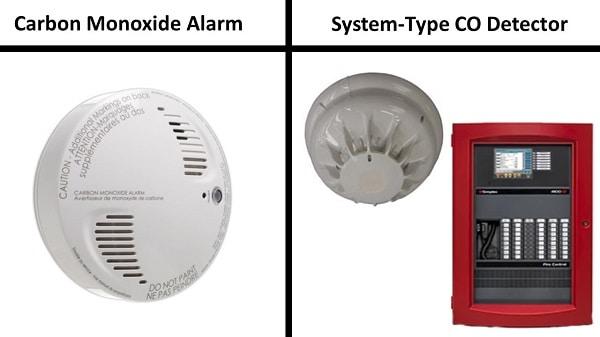
Where carbon monoxide detection is needed
Carbon monoxide is a byproduct of combustion produced when fuel (natural gas, propane, oil, gasoline) burns in the presence of insufficient oxygen. Where carbon dioxide (CO2) should have been made, one oxygen atom instead bonds to a carbon atom. Machines that can produce CO include (but aren’t limited to):
- Boilers
- Water heaters
- Furnaces
- Stoves and ovens
- Automobiles
- Generators
- Dryers
- Fireplaces
- Grills
Most of the time, CO gas is safely vented outside. Only during a malfunction, such as a blocked exhaust vent, or a misuse of equipment (such as running a car in a closed garage or a generator indoors) does the gas become a threat.
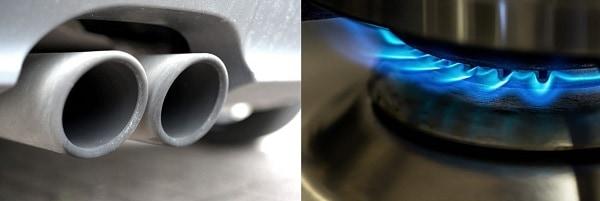
Because CO is only a problem where fuel burns, the International Building Code bases its rules about where detection is needed on the presence of related equipment. If a building has sources of CO, it needs carbon monoxide detection.
Other standards, including the International Residential Code (IRC), NFPA 101: Life Safety Code, and NFPA 5000: Building Construction and Safety Code, also cover carbon monoxide detection. Depending on the building type and which documents have been adopted by your jurisdiction, you may have to reference a different code instead of the IBC or one of its legally enforceable government versions.
We’ll focus on the IBC because it is in force at some level in all 50 US states. Also, NFPA 101 and NFPA 5000 break down their CO detector rules by occupancy class. IBC also includes occupancy, but its CO rules are found in one chapter and based on the single above-mentioned principle.
Within this framework—the presence of a CO source requires a CO detector or alarm—there are 5 general situations to consider:
- Residential buildings (dwelling units and sleeping units)
- Buildings with attached private garages or vehicles used within a building
- Buildings that contain or are supplied by a fuel-burning, forced-air furnace
- Classrooms in educational occupancies
- All other facilities with fuel-burning equipment
The situations we discuss below specifically apply to new construction. In existing buildings, the IFC is typically applicable, which calls for carbon monoxide detection in:
- Residential buildings (dwelling units and sleeping units)
- Classrooms in educational occupancies
- Institutional facilities, including rehab centers, group homes, halfway houses, foster care, hospitals, nursing homes, psychiatric facilities, and daycares (1103.9, 915.2)
Residential structures
Because CO kills silently and gradually, carbon monoxide detection is essential anywhere people sleep. IBC refers to “sleeping units” (e.g., bedrooms) and “dwelling units” (places where people live, including detached homes, duplexes, apartments, and hotels.)
The IBC stipulates that carbon monoxide detection must be:
- In living spaces “in the immediate vicinity” of each separate sleeping area (915.2.1).
- Present in each sleeping unit/bedroom that contains a CO source or is served by a CO-producing forced-air furnace (915.2.2).
- However, if a bedroom doesn’t have a CO source and isn’t served by a forced-air furnace that burns fuel, detection isn’t needed in the bedroom. A detector immediately outside the sleeping area is sufficient, allowing a single device to cover multiple bedrooms.
Here’s another key wrinkle regarding sleeping and dwelling units: carbon monoxide alarms may be installed within them instead of detectors (915.3.1). In every other scenario discussed below, the requirement is always for system-type detectors.
Educational facilities
IBC and IFC refer to “Group E” occupancies, which include schools with occupant loads of six or more and daycares handling more than five children over 2-1/2 years old.
IBC explicitly states that a carbon monoxide detection system with detectors is needed in schools, and alarm signals “shall be automatically sent to an onsite location that is staffed by school personnel” unless the building’s occupant load is 30 or less (915.2.3). In the latter case, a local alarm will suffice.
Vehicles and private garages
IBC rightfully treats garages as significant sources of CO. A car left running in a closed garage can poison an entire structure.
IBC calls for carbon monoxide detection (915.2.5) in dwelling units, sleeping units, and classrooms that are “contiguous with” (shares openings and are on the same level as) an enclosed private garage.
However, these spaces that are more than one story above the garage or in buildings connecting to a garage “through an open-ended corridor” are exempt. The in-room detector requirement can also be replaced by providing a detector in an [AHJ] approved location between openings to a garage and dwelling units, sleeping units, and classrooms. (915.2.5).
These rules do not cover “open garages,” which are non-enclosed structures like carports or open-air parking garages (406.5), or enclosed parking garages that have mechanical ventilation systems (406.6).
Additionally, gas-powered vehicles are used indoors in some commercial and industrial settings. Where this is true, CO detection systems are needed in the spaces they will operate (915.2.6).
CO-producing, forced-air furnaces
A furnace is the primary source of carbon monoxide in many buildings, and a malfunctioning forced air furnace can distribute the gas to every room of a structure. To meet this challenge, IBC says that any building with this equipment must either:
- Have CO detection in every room served by the HVAC system (915.2.4) or
- Have a CO detector (part of a detection system) in “the first room or space served by each main duct leaving the furnace, […] as long as alarm signals are automatically transmitted to an approved location” (915.2.4).
These rules specifically apply to non-residential buildings; compliance with the rules for dwelling units is sufficient protection in places where people live.
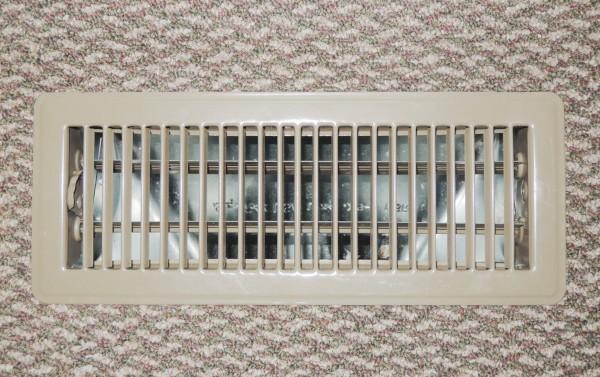
All other locations
If a facility doesn’t fall into any of the above categories but still has a potential source of carbon monoxide, it still requires detectors (915.2.6). These devices must be on the ceiling of an enclosed room with a CO source or an approved location contiguous to the room if that’s not possible.
An important note: Previous editions of the IBC and some currently legally enforceable government versions of this model code do not have this final catch-all rule. Nevertheless, the expanded requirements highlight the threat of CO and will be adopted eventually.
Testing carbon monoxide detectors (and other ITM)
Like most safety equipment, simply having carbon monoxide detectors is not enough. They require inspection, testing, and maintenance (ITM) to ensure they function when needed.
NFPA 72: National Fire Alarm and Signaling Code has the requirements for carbon monoxide detector ITM. Below is an overview of what it says about visual inspection for all types of CO detectors, testing for alarms and system detectors, and maintaining and replacing batteries.
However, keep in mind that NFPA 72 has many broader ITM tasks for complete alarm systems and their control panels that we don’t cover.
Alarms vs. detectors in NFPA 72
Like the IBC, NFPA 72 distinguishes CO detectors that are part of an alarm system from individual CO alarms, and it also breaks down alarms into two subcategories:
- Single-station alarms are integrated devices with “a sensor, control components, and an alarm notification appliance in one unit.” (3.3.278)
- Multiple-station alarms are single-station alarms that can be networked together and sound an alert together (3.3.178)
The alarms in either setup, solo or networked, lack a connection to a system control panel.
Visual inspections of CO detectors happen semiannually—and alarms at least monthly
NFPA 72 calls for a semiannual visual inspection of system-type CO detectors to verify their presence and condition (2022 edition: Table 14.3.1). Responsible parties put eyes on their devices twice a year to ensure that:
- They are where they should be
- They seem to be in working condition
If a device is missing or appears damaged, address the issue.
Alarms call for more frequent inspections, with section 14.4.5.2 specifying that “Alarms and connected appliances shall be inspected and tested at least monthly” following the manufacturer’s instructions.
However, various manufacturers of the standalone CO alarms often used in homes recommend or demand weekly tests (which also naturally include an inspection) in their instruction manuals. This interval may not seem practical to many homeowners. Still, at least the process is easy: manufacturers specify simply pushing and holding the test button (no functional testing) on each alarm. The instructions usually say to clean the equipment monthly.
Nevertheless, occasionally testing home CO alarms with actual CO gas isn’t necessarily a bad idea. It verifies the entire device works well, not just the power source.
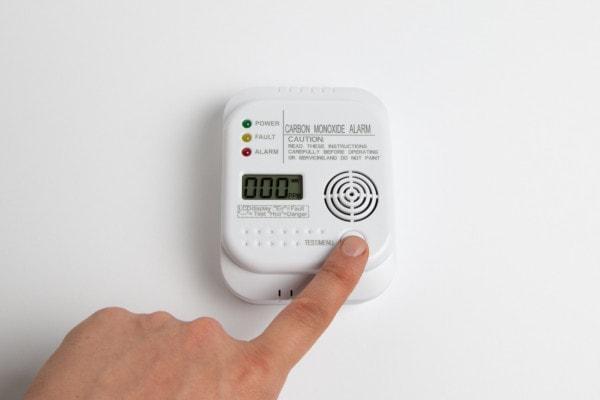
Testing carbon monoxide detectors (system-type detectors)
Assessing carbon monoxide detectors that are part of a system always goes beyond just pressing the “test” button. NFPA 72 requires a functional test where actual carbon monoxide is applied to the device. If the detector generates an alarm, it passes.
This test should happen at system acceptance (or reacceptance if taken out of service for maintenance) and annually (14.4.3.5). More specific information on how the test should be performed will come from the carbon monoxide detector’s manufacturer (14.2.2.1.1).
You can buy cans or capsules of aerosol carbon monoxide for this purpose. Solo™ and Testifire™ make equipment that dispenses controlled amounts of carbon dioxide, and compatible telescopic poles are available, making it easy to quickly assess numerous devices without a ladder. QRFS also stocks a wide range of fire protection products and fire sprinkler system components. Don’t forget to check out our smoke detector testers, carbon monoxide detector testing equipment, and fire alarm duct detector.
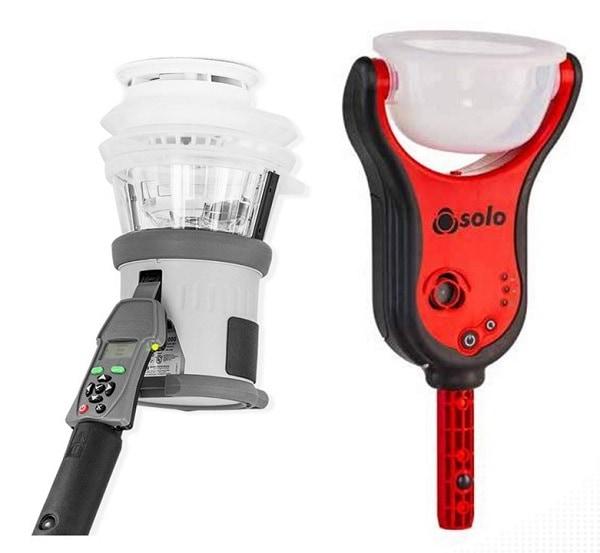
Testing household CO alarms
Carbon monoxide alarms commonly used in homes and bedrooms also require assessments, of course. We’ve already covered testing CO alarms in the inspection section above: “at least monthly” and according to the manufacturer’s instructions (14.4.5.2), though those documents often specify weekly.
Again, manufacturers usually don’t specify functional tests, though it’s reasonable to conduct them occasionally.
Household system-type CO detectors
NFPA 72 outlines different ITM for system-type CO detectors in its section on “Household Carbon Monoxide Detection Systems:”
- Like alarms, the code calls for testing CO detectors following manufacturers’ instructions, but Table 14.4.3.2 outlines annual functional testing requirements, including a gas entry test (conducted with canned CO).
- NFPA 72 also mandates broader system testing by a qualified service technician at least every three years (14.4.8.1.1-2).
The code judges that an “occupant of a dwelling unit shall be deemed qualified to perform inspection, testing, and maintenance on an alarm system” when they have “information and training from the manufacturer or a manufacturer’s certified representative” (14.4.8.1.3).
Maintenance: batteries and end-of-life replacement
CO detectors and alarms don’t have moving parts, so there’s very little maintenance. NFPA 72 mentions only two points.
- If a detector or alarm uses batteries, they should be replaced on the manufacturer’s schedule (14.4.5.9)—usually when the device chirps a low-battery message.
- When the device’s end-of-life happens (announced by a signal from the equipment or via a timeline in the manufacturer’s instructions), it should be replaced (14.4.5.7-8).
Carbon monoxide detectors and alarms save lives. Install and test them!
Carbon monoxide can kill, so codes and common sense demand a way to sense it. Properly installing and maintaining alarms or detectors are essential for safety infrastructure and planning.
Put simply, any building with some sort of fuel-burning equipment needs CO detection. However, IBC, NFPA 101, NFPA 5000, and other codes have more specific rules for different spaces and buildings.
Make sure to inspect and test the system to ensure it’s ready to go when you need it. Codes mandate functional testing of system-type detectors, and it’s a reasonable move for alarms, too. Directly applying real carbon monoxide gas lets you know the equipment truly works—not just that the power supply does.
Shop QRFS’s tools for testing carbon monoxide detectors and alarms, including cans of compressed CO, CO capsules, aerosol dispensers with telescoping poles, and complete multi-device testing kits that tackle CO, smoke, and heat detectors.
Contact us at 888.361.6662 or support@qrfs.com with any questions—we’re here to make fire protection simpler and easier!
This blog was originally posted at blog.qrfs.com. If this article helped you, check us out at Facebook.com/QuickResponseFireSupply or on Twitter @QuickResponseFS.


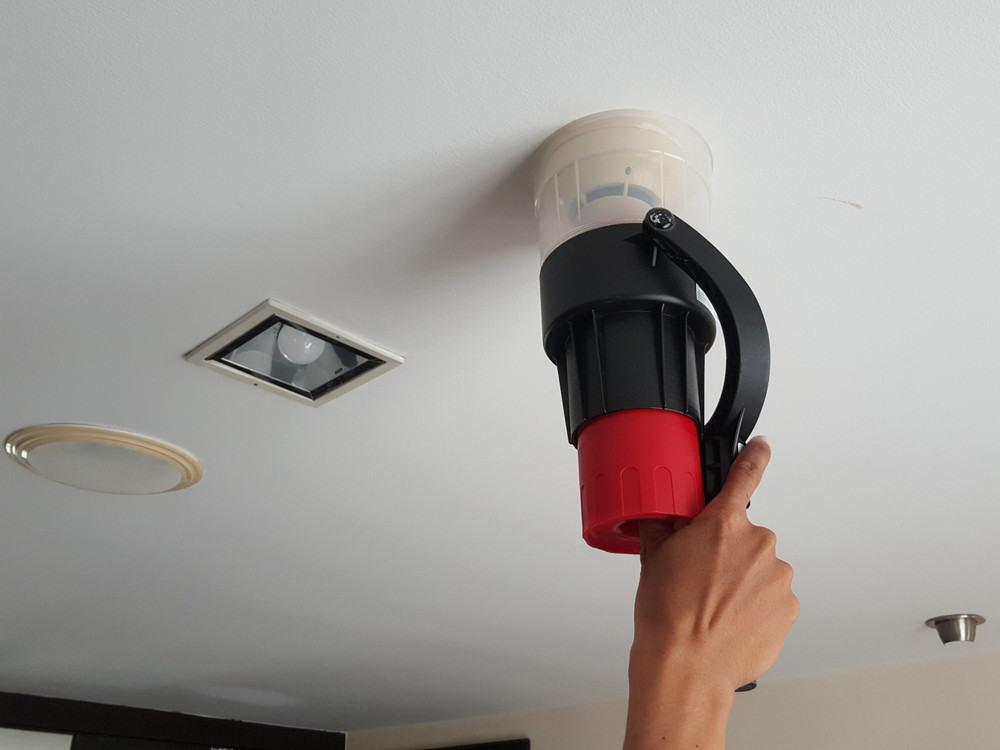
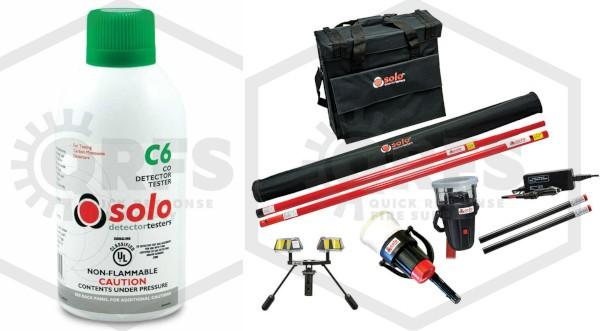
How close to a garage door do I need a CO detector?
Larry — ADT, a major manufacturer, advises “At least 10 feet from the garage door leading to your home. You should also place a sensor in the room above the garage. [If applicable.]”
Hi go a question for you it seem my co alarm may be mounted to a wall or ceiling and is not easily movable can use the co test aresol by attaching the test straw and pointing it in the alarm grill? Thoughts please thank you
Porong — Yes, pointing the CO at the grill is the basic procedure. You can read the instructions based on what tester you have in this document. if you need extra reach, you may want to look at dispensers and poles or complete test kits. Thanks for reading!